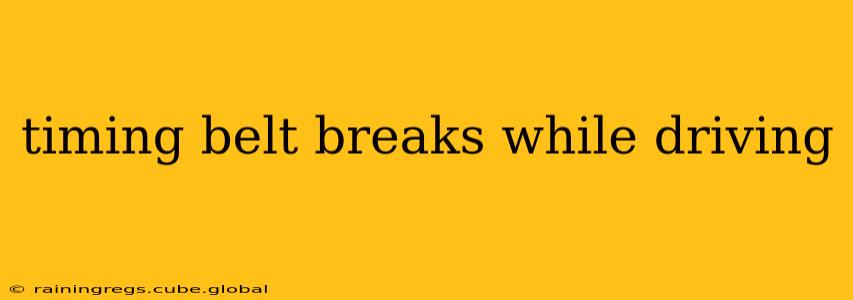A broken timing belt is a catastrophic event for any car owner. Unlike a serpentine belt, which primarily powers accessories, a timing belt synchronizes the crankshaft and camshaft, controlling the engine's valves. When it snaps while driving, the consequences can range from inconvenient to devastating, depending on the engine design and the speed at which you were traveling. This article will explore what happens when a timing belt breaks while driving, what to do immediately afterward, and how to prevent this from happening in the future.
What Happens When a Timing Belt Breaks While Driving?
The immediate effect of a broken timing belt depends heavily on the type of engine. Engines using interference engines are particularly vulnerable.
-
Interference Engines: In interference engines, the pistons and valves share the same space. When the timing belt breaks, the valves can be bent or damaged by the pistons as they continue to move independently. This results in significant internal engine damage, often requiring a complete engine rebuild or replacement. The engine will likely seize up, stopping abruptly. You’ll hear a loud bang or clattering sound followed by immediate engine failure.
-
Non-Interference Engines: These engines have more clearance between the pistons and valves. While a broken timing belt will still stop the engine, the damage is often less severe. The valves are unlikely to be bent, and the damage may be limited to the belt itself and perhaps some minor components. The engine will stop running, but the extent of damage is generally less severe than with an interference engine. However, you still shouldn't attempt to restart it.
Regardless of the engine type, the immediate consequences are typically:
- Complete engine stoppage: The car will lose power and come to a halt.
- Loss of power steering: Many power steering systems are belt-driven, although not by the timing belt itself. A related belt may also break due to the initial failure event.
- Loss of brakes (in some cases): Power-assisted braking systems rely on engine power and a functioning belt system which might be affected by the failure.
- Possible warning lights: Your dashboard may flash various warning lights, indicating engine failure and loss of systems.
What to Do if Your Timing Belt Breaks While Driving?
Safety First! This is paramount.
- Pull over safely: Turn on your hazard lights and find a safe location, away from traffic, to pull over.
- Turn off the ignition immediately: Do not attempt to restart the engine. Restarting a car with a broken timing belt, especially in an interference engine, can cause further, irreparable damage.
- Call for roadside assistance: Have your car towed to a qualified mechanic. Don't attempt to drive it further.
- Assess the situation: Check for any visible damage or leaks around the engine bay. However, do not attempt any repairs yourself.
- Contact your insurance company: If you have roadside assistance or coverage for mechanical breakdowns, inform your insurance provider immediately.
How Much Does it Cost to Replace a Timing Belt?
The cost to replace a timing belt varies depending on the make, model, and year of your vehicle as well as the labor rates in your area. It's generally considered a major service, requiring specialized tools and expertise. Expect a significant expense involving both parts and labor.
How Often Should I Replace My Timing Belt?
Timing belt replacement intervals are specified by the vehicle manufacturer and vary widely. Consult your owner's manual for the recommended replacement schedule. Ignoring this schedule drastically increases the risk of a catastrophic failure. It's usually measured in miles or years, whichever comes first.
Can a Timing Belt Break Without Warning?
While some belts might show signs of wear such as cracking or fraying, many failures occur without any obvious prior warning. This is why regular maintenance and adherence to the manufacturer's recommended replacement schedule is crucial.
What are the Signs of a Failing Timing Belt?
While often unpredictable, some subtle signs might indicate an impending failure, though they are not guaranteed predictors:
- Unusual noises: Squeaking, squealing, or knocking sounds from the engine, particularly when starting or under acceleration.
- Visible wear and tear: Inspect the belt for cracks, fraying, or glazing. However, you need some mechanical expertise to do this safely.
In conclusion, a broken timing belt is a serious issue requiring immediate attention. Prevention through regular maintenance and timely replacement is far less costly and far safer than dealing with the aftermath of a roadside breakdown. Regular checks and adherence to your owner's manual's recommended maintenance schedules are essential for avoiding this potentially expensive and dangerous scenario.
